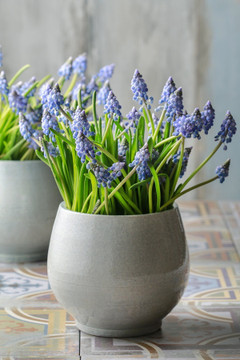


This native flower will instantly elevate the charm and distinctiveness of your spring garden. Yes, we said that word that so many people look for...."Native!" These wild beauties have covered grasslands and prairies across the South. The Camassia scilloides has several different common names including "Wild Hyacinth," "Quamash," and "Camas." The star-shaped blooms can vary from an almost white to violet, but these are a bluish-lavender. This is a great plant to help hide the foliage of spring-bloming bulbs.

What to expect: This bulb will put on its foliage in February to prepare for its April bloom. The plant grows to about two (2) feet tall and has spikes with several inches of small star-shaped flowers running up and down the spike. Once the flowers are dead, the green foliage will add to your garden for another month or two. Allow the foliage to die back naturally. When it is completely dead, then you can cut if off. Remember, the foliage is what takes in the sun energy to allow the bulbs to make it through the year and produce beautiful blooms the next year.
They make lovely cut flowers as the flower shoot is separate from the leaves. Cutting the shoot does not damage the plant itself.

Mulitplying: The Camassia not only muliplies from offshoots, but it also reseeds itself though it will take several years. Camassia does NOT work well in containers. It likes to be left alone once planted.

Sun and Planting Requirements: They need at least 6+hours of sun from February through June. They do great with full sun but can do well in dappled open shade like on the edge of a wooded area. Plant them about 4 inches deep and 6-8" apart with their pointy end up. These work best in zones 4-8 so they will bloom a little earlier in zone 8 (April) than they will in zone 4. They do best in well-drained soil, but they can tolerate clay as long as they receive good watering. It will also take them longer to multiply in clay soil.
Though they can tolerate wet spring conditions, they do not like to stay wet. Don't plant them in an area that is still wet 5-6 hours after a rain.

Animals: Bees and butterflies are really drawn to this April/May bloom. The Camassia is extremely resistant to deer, voles, and other ground animals.
Fun Facts:
Though we don't recommend it, Native Americans and early settlers would eat the Camassia bulbs.

This native flower will instantly elevate the charm and distinctiveness of your spring garden. Yes, we said that word that so many people look for...."Native!" These wild beauties have covered grasslands and prairies across the South. The Camassia scilloides has several different common names including "Wild Hyacinth," "Quamash," and "Camas." The star-shaped blooms can vary from an almost white to violet, but these are a bluish-lavender. This is a great plant to help hide the foliage of spring-bloming bulbs.

What to expect: This bulb will put on its foliage in February to prepare for its April bloom. The plant grows to about two (2) feet tall and has spikes with several inches of small star-shaped flowers running up and down the spike. Once the flowers are dead, the green foliage will add to your garden for another month or two. Allow the foliage to die back naturally. When it is completely dead, then you can cut if off. Remember, the foliage is what takes in the sun energy to allow the bulbs to make it through the year and produce beautiful blooms the next year.
They make lovely cut flowers as the flower shoot is separate from the leaves. Cutting the shoot does not damage the plant itself.

Mulitplying: The Camassia not only muliplies from offshoots, but it also reseeds itself though it will take several years. Camassia does NOT work well in containers. It likes to be left alone once planted.

Sun and Planting Requirements: They need at least 6+hours of sun from February through June. They do great with full sun but can do well in dappled open shade like on the edge of a wooded area. Plant them about 4 inches deep and 6-8" apart with their pointy end up. These work best in zones 4-8 so they will bloom a little earlier in zone 8 (April) than they will in zone 4. They do best in well-drained soil, but they can tolerate clay as long as they receive good watering. It will also take them longer to multiply in clay soil.
Though they can tolerate wet spring conditions, they do not like to stay wet. Don't plant them in an area that is still wet 5-6 hours after a rain.

Animals: Bees and butterflies are really drawn to this April/May bloom. The Camassia is extremely resistant to deer, voles, and other ground animals.
Fun Facts:
Though we don't recommend it, Native Americans and early settlers would eat the Camassia bulbs.